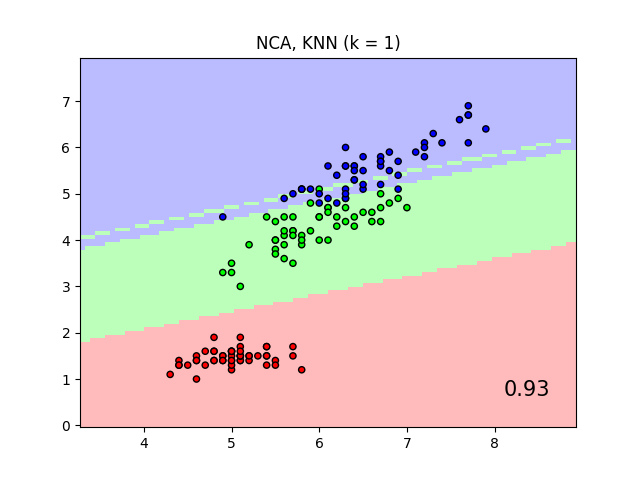Note
Go to the end to download the full example code. or to run this example in your browser via Binder
比较有无邻域成分分析的最近邻分类#
一个比较有无邻域成分分析的最近邻分类的示例。
它将绘制在使用原始特征的欧几里得距离时由最近邻分类器给出的类决策边界,与使用邻域成分分析学习的变换后的欧几里得距离时的类决策边界。后者旨在找到一种线性变换,以最大化训练集上的(随机)最近邻分类准确性。
# SPDX-License-Identifier: BSD-3-Clause
import matplotlib.pyplot as plt
from matplotlib.colors import ListedColormap
from sklearn import datasets
from sklearn.inspection import DecisionBoundaryDisplay
from sklearn.model_selection import train_test_split
from sklearn.neighbors import KNeighborsClassifier, NeighborhoodComponentsAnalysis
from sklearn.pipeline import Pipeline
from sklearn.preprocessing import StandardScaler
n_neighbors = 1
dataset = datasets.load_iris()
X, y = dataset.data, dataset.target
# 我们只取两个特征。我们可以通过使用一个二维数据集来避免这种丑陋的切片操作。
X = X[:, [0, 2]]
X_train, X_test, y_train, y_test = train_test_split(
X, y, stratify=y, test_size=0.7, random_state=42
)
h = 0.05 # step size in the mesh
# 创建色彩映射
cmap_light = ListedColormap(["#FFAAAA", "#AAFFAA", "#AAAAFF"])
cmap_bold = ListedColormap(["#FF0000", "#00FF00", "#0000FF"])
names = ["KNN", "NCA, KNN"]
classifiers = [
Pipeline(
[
("scaler", StandardScaler()),
("knn", KNeighborsClassifier(n_neighbors=n_neighbors)),
]
),
Pipeline(
[
("scaler", StandardScaler()),
("nca", NeighborhoodComponentsAnalysis()),
("knn", KNeighborsClassifier(n_neighbors=n_neighbors)),
]
),
]
for name, clf in zip(names, classifiers):
clf.fit(X_train, y_train)
score = clf.score(X_test, y_test)
_, ax = plt.subplots()
DecisionBoundaryDisplay.from_estimator(
clf,
X,
cmap=cmap_light,
alpha=0.8,
ax=ax,
response_method="predict",
plot_method="pcolormesh",
shading="auto",
)
# 还要绘制训练点和测试点
plt.scatter(X[:, 0], X[:, 1], c=y, cmap=cmap_bold, edgecolor="k", s=20)
plt.title("{} (k = {})".format(name, n_neighbors))
plt.text(
0.9,
0.1,
"{:.2f}".format(score),
size=15,
ha="center",
va="center",
transform=plt.gca().transAxes,
)
plt.show()
Total running time of the script: (0 minutes 0.338 seconds)
Related examples






